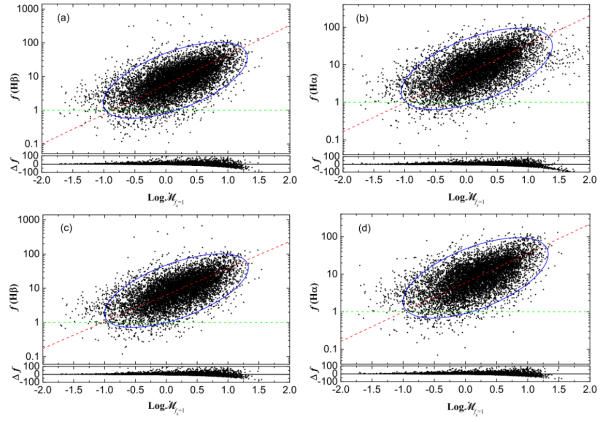In the Yunnan observatories of the Chinese Academy of Sciences, Prof. LIU Hongtao, PhD FENG Haicheng, and their cooperators, recently investigated the influence of radiation pressure on the measurement of the virial masses of supermassive black holes (SMBHs) in active galactic nuclei (AGNs). Their research, which is based on the redward-shifted broad emission lines Hβ and Hα, was published online in The Astrophysical Journal.
It is widely accepted that the radiation pressure is negligible when measuring the true masses of SMBHs in AGNs (denoted as MBH) by the virial masses of SMBHs (denoted as MRM) based on broad emission lines. Additionally, it is commonly believed that the virial factor f in MRM is independent of the radiation pressure. Nonetheless, the most significant source of error in MRM is the uncertainty of the virial factor f, which can lead to a systematic error of up to ~ 300% to 400%. Despite these challenges, the accurate measurement of MBH is crucial for investigating early cosmic SMBHs, quasars, and the coevolution of SMBH and host galaxy, etc.
Utilizing the Sloan Digital Sky Survey Data Release 7, the researchers selected more than 9000 AGNs based on the broad Hβ lines that are redward-shifted relative to the host galaxy of SMBH, and also more than 9000 AGNs based on the redward-shifted broad Hα lines. Among these, more than 8000 AGNs have both the redward-shifted Hβ and Hα. The team measured f for these selected AGNs based on lines widths and shifts of redward-shifted Hβ and Hα, and found a positive correlation between the virial factor and dimensionless accretion rate of SMBH. This finding suggests that radiation pressure significantly influences the measured virial factor which contains the inclination effects of broad-line region (BLR). The analysis shows that the redward shifts of the broad Hβ and Hα are dominated by the gravity of the central SMBHs.
The measured f values span a large range, with f > 1 for over 96% of AGNs. The f-correction makes the percentage of high-accreting AGNs decrease by about 100 times, and blurs the distinction between high- and low-accreting sources.
For 113 quasars with a redshift (z) greater than or approximately equal to 6, the f-correction causes them to transition from near-Eddington accreting sources to low-accreting sources. The f-corrected masses indicate that these quasars have more massive early black hole seeds and longer growth times, supporting the heavy-seed origin scenarios of early SMBHs. These results will make it more challenging to explain the formation and growth of SMBHs at z >/~ 6.
Interestingly, the researchers found that 62 AGNs and 88 quasars beyond the local Universe do not follow the local MBH-sigma relations, where sigma is the stellar velocity dispersion of the galaxy bulge. However, these 150 sources roughly follow the f-corrected MBH-sigma relation of the local luminous AGNs. These findings might illuminate possible redshift evolution in the MBH-sigma relationship.
In conclusion, these results demonstrate that the radiation pressure on the gravitationally bound BLRs of AGNs is prevalent and non-negligible. These new findings enable people to better understand the fundamental physical processes in the central region of AGNs, the accretion states of the first-generation quasars, and the formation mechanism and evolution paths of early cosmic SMBHs.

Figure 1: The virial factor vs. the dimensionless accretion rate. Panel (a): for Hβ of 9185 AGNs. Panel (b): for Hα of 9271 AGNs. Panel (c): for Hβ of 8169 AGNs from Hβ∩Hα. Panel (d): for Hα of 8169 AGNs from Hβ∩Hα. The dashed green line denotes f =1.0 usually used. The dashed red line denotes the best bisector linear fit. The blue solid line denotes the 95% confidence ellipse. △f is the fitting residuals. Image by LIU.

Figure 2: MBH-sigma map for 62 AGNs (solid circles) and 88 quasars (open squares). The black symbols correspond to MRM, and the colored symbols are fMRM. The blue dashed line is the Tremaine et al. (2002) relation for nearby inactive galaxies. The olive dashed line is the Woo et al. (2013) relation for nearby quiescent galaxies. The magenta dashed line is the McConnell & Ma (2013) relation for 72 nearby galaxies. The cyan dashed line is the Caglar et al. (2020) relation for local luminous AGNs. The cyan dashed-dotted line is the Caglar et al. (2020) relation moved vertically upward by an order of magnitude. Image by LIU.
Contact:
LIU Hongtao
Yunnan Observatories, CAS
htliu@ynao.ac.cn